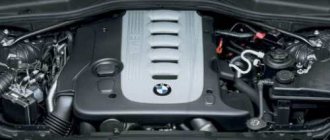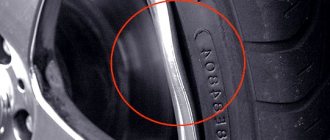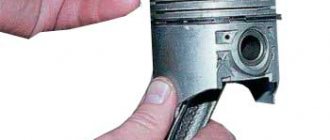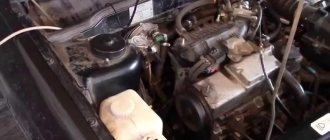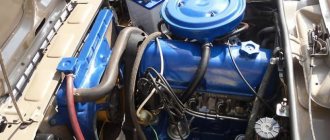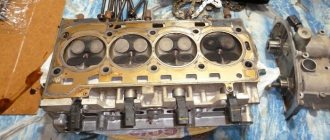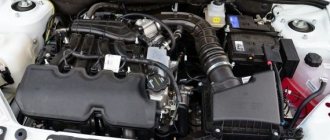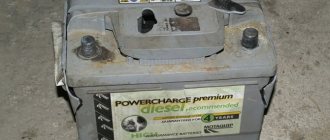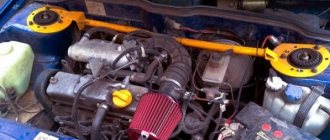For example, the Toyota Land Cruiser 200 SUV is equipped with an eight-cylinder power unit. Depending on the number of problem cylinders, this engine can have “seven” or “six”, and so on. However, they still say that “the engine started to misfire.” The Oka has a two-cylinder engine, which means that in case of problems it will be “alone”, but out of habit they talk about tripling.
Now four-cylinder engines are installed en masse in VAZ and GAZ cars. Everything matches here. When they say that a Gazelle engine is tripping, it means that three out of four cylinders are functioning. It’s the same with Ladas – the name of the fault can be taken literally.
Signs of a problem
When the engine starts to stall, the driver feels it based on a number of signs:
- strong vibration at idle,
- drop in engine power,
- Difficulty starting a cold engine.
If you experience any of these symptoms, there is likely a problem with one of your vehicle's cylinders. Or the problem is general, but in one cylinder it manifests itself clearly. What to do in such cases? Let's figure out why the engine is tripping, then it will become clear how to deal with this malfunction.
Let’s be clear right away - the engine can stall when cold, at idle, or in any operating mode. Why might a cylinder refuse to work? In fact, there are only three options: either there is nothing to burn, or there is nothing to ignite (for gasoline internal combustion engines), or there is not enough oxidizer (low compression). Therefore, when the engine stalls, the reasons must be sought either in the fuel supply, or in the generation of a spark, or in low compression (especially for diesel engines).
If the engine starts to stall, you should immediately troubleshoot the problem. Otherwise, you will get accelerated engine wear, increased fuel consumption and the possibility of a major accident at any time. This is due to the fact that fuel may continue to flow into the idle cylinder. It washes away the oil from the walls of this cylinder and dilutes the oil in the crankcase, which leads to increased wear, scuffing, and in extreme cases, an explosion of fuel vapors can occur.
Symptoms of breakdown
Typically, drivers learn about the problems under consideration by the characteristic sound of the engine, the sound of the exhaust and the resulting vibrations. In addition, the “CheckEngin” indicator lights up on the dashboard.
The following can also be used to determine engine tripping:
- unstable idle speed;
- drop in power indicators;
- increased fuel consumption;
- vibrations of the body and/or engine block.
Here you need to take into account that such symptoms can also indicate other malfunctions, and therefore an integrated approach to identifying the cause is needed.
Engine diagnostics
First you need to find the non-functioning cylinder. There is a simple and clear way for gasoline engines. At idle speed, it is necessary to disconnect the high voltage wires one by one, supplying a discharge to the spark plug. When the electrical supply is cut off at the working cylinder, the engine starts to rev harder. If the non-working one is turned off, there will be no changes in the operation of the motor. Care should be taken to avoid receiving a harmless but painful electric shock.
When the VAZ direct injection injector of the engine is damaged, the search for a non-functioning cylinder is simplified. There is no need to climb into the wires and risk getting an electric shock. It is enough to turn off the control of the injectors one by one. You also need to find a cylinder that, when turned off, does not change the behavior of the power unit.
When diagnosing a diesel engine, you need to turn off the fuel supply one by one. For example, you can simply unscrew the fuel line nuts. The goal is the same - to find a cylinder, when turned off, the engine runs without changes.
ECU
The reasons for unstable engine operation should sometimes be sought in the computer if diagnostics of other parts and systems did not help. The engine control unit breaks down infrequently. But, if this happens, the device will need to be replaced or reflashed. It is not recommended to do these operations yourself. Therefore, if you suspect a unit failure, you should contact a service station within a reasonable time for diagnosis and repair. A new part is not cheap, but a replacement will prevent more serious damage to the power unit and restore its normal operation. A characteristic sign of a unit malfunction is tripping not only when the engine is cold, but also when the engine is warm.
Finding the reason
Having found out which cylinder is causing the engine of a VAZ or a car of another brand to fail, we proceed to further research. You need to remove the spark plug and inspect it for the presence of gasoline. If the contacts are wet, it means either there is no spark, or the mixture is excessively rich or, on the contrary, lean.
If the candle is to blame
Install a known good spark plug and check the operation of the cylinder. If it starts working, you need to change the spark plug; if it doesn’t work, then the reason why the engine is throbbing is something else. We continue to search.
Problems with wiring or ignition distributor
The next thing to look at when there is no spark is the high voltage wiring. It is necessary to check the condition of the contacts and insulation. Are the terminals intact, free of corrosion, and is the insulation free of cracks? So the problem is elsewhere. Is there any damage? Replace the cable and check the performance of the spark plug again.
There is an express way to check high-voltage wires. It is necessary to start the engine, which has started to stall, in the dark - at night or in a windowless box with the lights off. Under such conditions, all breakdowns will be clearly visible in the form of sparks. With such a malfunction, the voltage simply does not reach the spark plug, so it does not spark.
If the wiring is OK, inspect the distributor cap. Due to a malfunction of this device, different cylinders work intermittently in turn. Cracks on the cover are a clear sign that one of the contacts in the ignition distributor has burnt out, so the engine began to stall.
Air intake from outside
If the spark plug is working properly and the discharge is supplied to it as normal, then the problem is in the air-fuel mixture. Sometimes the intake of air from outside dilutes the injection of gasoline to a concentration at which the mixture does not ignite.
The reasons for air getting into the cylinder can be very different: from damage to the intake manifold pipe to depressurization of the cylinder head seals. This is manifested by the fact that the engine stalls at speed and stalls when the load increases.
To fix the problem, you need to replace the damaged duct or seals. It is possible that air is leaking through the cylinder head gasket. You can replace the gasket yourself or contact a specialist.
Insufficient compression
Sometimes compression in the combustion chamber does not reach the desired value due to loss of tightness. If the mixture is not compressed to the desired level, the concentration of gasoline vapor is insufficient to ignite. Often the cause is stuck piston rings.
Due to accumulated deposits, the rings “stick” to the piston grooves and do not provide proper tightness. During the compression stroke, the air-fuel mixture seeps through the gaps of the piston-cylinder pair. Compression drops, fuel does not ignite.
In diesel engines, fuel spontaneously ignites due to high temperature when air is compressed. And if the compression is insufficient, then there will be no ignition. The quality of fuel atomization is also important here. If the high pressure fuel pump or injectors do not meet the specified parameters, then the fuel will not be evenly distributed in the combustion chamber in thin droplets, but will be “poured” or injected in large droplets. Such a spray of fuel, even with good compression, can lead to cylinder failure.
If the air duct is in good condition, but signs of malfunction have recently appeared, use Suprotec Active Plus tribological compound. It is added to motor oil. In terms of its mode of action, it is an engine additive; it does not change the composition of the lubricant and does not react with its components.
Engine oil additive "Suprotek Active Plus"
Restores compression, reduces fuel consumption and oil waste, reduces wear rate and extends the life of internal combustion engines of any type. Facilitates cold starts and protects against overheating in traffic jams.
more reviews
The Suprotek Active Plus product improves the operation of valves and the oil pump by removing contaminants from friction pairs. The product also restores worn parts of the cylinder-piston group at a microscopic level. The tribo composition is capable of decoking stuck piston rings if the case is not completely advanced.
This set of factors helps restore compression in the combustion chamber to nominal values. The gaps in the friction pairs are normalized, and a thicker film of lubricant is retained on the parts. The cylinder operation returns to normal.
Of course, in advanced cases, when there is already wear on the inner surface of the cylinder, the additive will not help. This problem can only be solved by overhauling the engine with boring the cylinder and installing oversize pistons or lining.
To maintain in good condition and restore the characteristics of the fuel equipment of a diesel engine, it is recommended to use the Suprotek TNVD fuel additive.
Fuel additive "Suprotek TNVD"
Additive for high-pressure fuel pumps of diesel engines of any design (in-line, distribution, main in Common rail systems)
more reviews
Suprotek MAX injection pump additive for trucks
For injection pumps of diesel internal combustion engines of trucks and special equipment: in-line, distribution, main fuel pumps, COMMON RAIL systems, PUMP-NOZZLE systems.
more reviews
Air supply
Excess air or lack of it is the reason that causes engine tripping. Occurs due to the system losing its tightness. The power unit begins to suck in air, the electronics do not take this process into account, and as a result, the functioning is disrupted.
Injector nozzles
Everyone will be able to check the air system, since there is nothing complicated in the procedure.
- The inlet hose located near the air filter is blocked.
- Pressure is created in the system.
- The location of the leak is checked by reducing the pressure.
It is clear that if the pressure does not drop, then the system is completely sealed. On the contrary, if the air comes out with a hiss, then this will not only verify the leakage, but also determine the specific location of the leak.
As for the lack of air, this is due to a dirty air filter. The latter loses its capacity. What should be done. Remove the filter and evaluate the operation of the power unit without it. If there is no difference, then the air filter is not doing its job at all and needs to be replaced.
Insufficient air may also be due to throttle problems. It is also important to clean and check it in a timely manner. It is advisable to carry out the procedure during each scheduled maintenance, simultaneously with the replacement of filters, oil, etc.
Injector temperature sensor
As mentioned above, the cause of engine tripping on the injector can be sensors. They send impulses to the electronic unit. If the signal is erroneous, then the electronics are not able to correct it. For example, if information is received that the engine is cold, but it has been running for an hour, the electronics will send an order to the injectors to inject enriched fuel assemblies. As a result, tripping and a lot of other troubles will arise, including in cold weather.
You need to check this way. First, test the information from the sensors and count the errors. Compare readings with standard values. If there are large deviations, then the cause of the tripling will be found.
When an injection engine fails
It is much more difficult to determine the cause of the malfunction if the engine with an injector is malfunctioning. Power units of this type are equipped with electronic systems that the uninitiated should not meddle with. The maximum that can be done is to check the condition of the spark plugs and injectors.
We have already covered how to check the ignition. With injectors the algorithm is approximately the same. We replace the nozzle of the non-working cylinder with a known good one. If it works, great.
For example, often due to this malfunction, the Kalina engine, a generally unpretentious power unit, fails. Replacing the injectors helps solve the problem. However, it is better not to bring the engine to this state. At the first sign of leakage, add SGA flush from Suprotec to the gas tank.
Detergent additive for gasoline "SGA (SGA)"
Cleans and lubricates fuel pumps and injectors, extends their service life. Improves injection, which reduces fuel consumption and increases dynamics. Suitable for any petrol systems, including TFSI, TSI, GDI, MDI.
more reviews
This mild additive flushes the injectors and protects them from corrosion and wear. The product also improves the operation of the fuel pump, valves and other moving parts of the fuel supply system. When used systematically, flushing "Suprotek SGA" significantly increases engine life.
If even after washing the check light is on, the engine is running, and no improvements are noticeable, then the nozzle already requires replacement. No additive will help, you need to change the nozzle. This is more expensive and takes more time than pouring an additive into the gas tank, so we recommend systematically engaging in prevention.
Malfunction of the injector or nozzles
The injection engine fails in the following cases:
- The injector is faulty, but this is very rare.
- Bad gasoline was poured in or fuel system cleaner was used incorrectly.
- Clogged injectors.
- The electrical power supply circuit for the injectors is open or shorted.
Engine diagnostics and a competent motor mechanic will help eliminate such malfunctions. To independently check the injector and nozzles, you need experience and special equipment.
If the engine stalls when cold
It happens that the engine stalls when cold only in wet weather. Having warmed up to normal temperature, the engine begins to operate normally. This is a clear sign that the insulation of one of the high-voltage wires is damaged. Due to dampness, electricity breaks through to the ground, the candle cannot produce a spark. When the engine warms up and dries, the leak bridge disappears and the engine runs normally. There is only one solution - change the high voltage wires. How to determine which of them is damaged was discussed above.
Spark generator
The first place where motorists usually look for a problem is the spark plugs. On old domestic cars this is done simply - using the old-fashioned method. The spark plug is unscrewed from the cylinder block.
Next, it is inserted into the tip and leans against the car body. Turn the ignition key for 1-2 seconds and you will see if there is a spark. This procedure should be repeated with all four candles. Of course, if there is a stand for checking spark plugs, then it is recommended to use it.
To check the high-voltage wires, you need to remove them from the vehicle and measure the resistance using a multimeter. The indicator should be about 5 ohm. For Zhiguli cars with a carburetor engine, it is recommended to use high-voltage wires manufactured by Tesla.
The VAZ 2106 engine uses a standard Zhiguli ignition coil, which can also fail. Therefore, it is recommended to diagnose this element as well. In case of failure, replace it.
If the engine stalls at idle
Are there any special reasons when the engine idles at idle? More likely no than yes. At idle, the engine may stall for any of the reasons discussed in this article. It makes no difference whether the problem is with a Peugeot, Kalina or a car of another brand. The algorithm for finding the causes of the malfunction is the same. If the engine revs only at low speeds, then a slight burnout of the valve is possible. At high speeds, the mixture or air does not have time to pass through the burnout, compression rises and the cylinder begins to work. This diagnosis is verified by examining the exhaust pipe. If oil flies out of it, then the valve is definitely burned out.
Timing marks
If the camshafts are incorrectly aligned relative to the crankshaft
– the reason for the engine tripping. The opening and closing timing of the intake and exhaust valves will not coincide with the engine strokes.
For example, at TDC of the piston the valve may be closed, so a flash will occur not only in the cylinder, but in the intake or exhaust manifold, depending on which valve is not closed.
This may occur due to a stretched timing drive.
. As the chain or belt is used, it stretches. Therefore, the opening or closing angles may shift. This leads to engine tripping.
What to do
If you have checked everything: the spark plugs are in order, there is a spark everywhere, the quality of the mixture is at the right level, you need to check the timing marks. We look at the degree of belt tension. In the case of a chain, how “out” the tensioner is. If the marks are knocked down, then we set them as needed.
Correctly set marks on the camshaft of a 16-valve engine
Correctly set marks on the camshaft of a 16-valve engine
After troubleshooting, we fix the problem. If the motor stops running, the cause has been found and eliminated.
Determination of non-working cylinder
In relation to engines running on liquid fuel, in order to eliminate the causes of friction, it is necessary to first understand which cylinder is the problem. There is one surefire way to do this, which all car mechanics use. The essence of it is to remove each wire going to the spark plug one by one. The algorithm of actions here is as follows:
- First you need to find a dielectric base on which the “diagnostics” will be performed. Any wooden board or rubber mat will do.
- Start the engine, keep the speed within 1500.
- Now you should grab the wire (not the cap!) and disconnect it from the spark plug. When the engine sound changes, we conclude that the working cylinder and wire can be installed in their place.
- Do the same with the remaining wires. And if, when one of them is disconnected, the sound remains the same, the “culprit” has been found.
Now you can actually start fixing the problem. But if certain difficulties arise, when it is difficult to determine which cylinder is faulty or it is impossible to eliminate the faults, you should visit a car service center.
Experienced technicians will take care of your car at a professional level. It is worth considering that operating a vehicle in the presence of friction is highly discouraged in order to avoid more serious problems.
Replacing spark plugs yourself
Of all the above problems, faulty spark plugs are the most common. Therefore, we will look at this problem in more detail.
Spark plugs must be replaced according to the established period, since only in this case can reliable and stable operation of the engine be ensured. As a rule, spark plugs are replaced after the car has traveled more than 20,000 kilometers (each brand has its own deadline), however, if the engine starts to trip, this element must be replaced before the established period.
Replacing spark plugs can be divided into the following stages:
- Before starting work, you need to clear the engine compartment of debris and dirt, since foreign elements cannot enter the cylinders.
- We remove the engine elements in order to gain unhindered access to the spark plugs. In some cases, it is almost impossible to remove all the elements for unhindered access to the spark plugs, since a huge number of elements will need to be disassembled. In order to remove the spark plugs in this case, you need to use special extensions and adapters. It is worth noting that before starting work you need to wait until the motor has completely cooled down, as you can get burned while doing it.
- We unscrew the spark plugs one by one, disconnecting the high-voltage wires. At the same time, we note that in order to prevent an accident, you must first remove the battery from the car, since in some cases, due to certain malfunctions, electricity may be supplied even when the ignition is turned off. When unscrewing, you need to monitor the force applied, because if the spark plug does not budge, it is better to have similar work done at a car service center. This is due to the fact that if the spark plug cannot be unscrewed, then there is a possibility of the thread breaking.
- To prevent debris from getting into the resulting holes, you need to cover them for a while.
- At the first stage, the spark plugs are screwed in using your hands, and then they are tightened using a special mechanism that allows you to measure the amount of force applied (in the absence of such a mechanism, the spark plug is screwed in another ¾ of a turn). High voltage wires are connected.
- Engine operation is checked.
- All elements are collected in reverse order.
To ensure stable engine operation, spark plugs must be replaced periodically. As can be seen from the above stages of carrying out such work, it can be done independently without the use of special tools.
